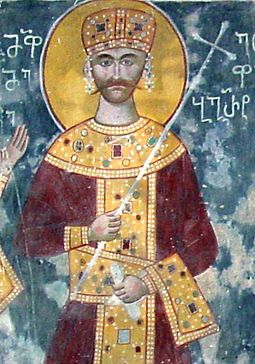Bagrat III of Imereti facts for kids
Quick facts for kids Bagrat III |
|
|---|---|

Bagrat III, a fresco from the Gelati Monastery
|
|
| King of Imereti (more...) | |
| Reign | April 1, 1510–1565 |
| Predecessor | Alexander II |
| Successor | George II |
| Born | September 23, 1495 |
| Died | September 1565 (aged 69–70) |
| Spouse | Elene |
| Issue | George II |
| Dynasty | Bagrationi |
| Father | Alexander II of Imereti |
| Religion | Georgian Orthodox Church |
| Khelrtva |  |
Bagrat III (Georgian: ბაგრატ III) was a powerful King of Imereti from 1510 to 1565. He was part of the Bagrationi dynasty, a very old royal family. Bagrat became king after his father, Alexander II, passed away.
During his rule, Bagrat faced many challenges. He had to deal with repeated attacks from the Ottoman Turks. He also had problems with some of his own princes. These princes ruled smaller areas like Mingrelia, Guria, and Abkhazia. They often caused trouble and sometimes even joined forces with the Ottomans against him.
Contents
Bagrat's Reign as King
In 1512, the Ottomans launched an attack on Imereti. They came through a southern area called Samtskhe. The Ottoman army surprised Bagrat by striking his capital city, Kutaisi.
After the Ottoman army left, King Bagrat started to rebuild his kingdom. He worked to make the church stronger. He also created a strict law against slave trading. This was a big problem at the time, as some people were selling Georgians into slavery. Bagrat made it a crime punishable by death.
Fighting Against Pirates and Ottomans
In 1533, Bagrat convinced two other Georgian princes to help him. These were Mamia I Gurieli of Guria and Mamia III Dadiani of Mingrelia. Together, they planned an attack against a group of pirates. These pirates were from the North Caucasian tribe called Zichi. They had become allies with the Turks and were causing problems. The expedition didn't go well, but Bagrat didn't give up.
Bagrat then decided to strike at the Ottomans in southern Georgia. In 1535, he invaded the principality of Samtskhe. The Ottomans were using Samtskhe as a way to enter Georgian lands. At the Battle of Murjakheti, near Akhalkalaki, Bagrat won a big victory. He captured Qvarqvare III Jaqeli, the prince of Samtskhe. Bagrat then added most of Samtskhe's lands to his own kingdom.
Challenges and Losses
Qvarqvare’s son, Kaikhosro, asked the Ottomans for help. The Ottoman army invaded Imereti again. But Bagrat and his ally, Rostom, the prince of Guria, managed to defeat them. However, the prince of Mingrelia, Levan I Dadiani, refused to help Bagrat. Instead, he sided with the Ottomans. Levan even traveled to Istanbul to get gifts and promises of protection from them.
In 1545, Bagrat and his ally Luarsab I of Kartli faced a tough defeat. This happened at the Battle of Sokhoista. Because of this loss, Samtskhe was taken away from Bagrat's control. It then came under the power of the Ottoman Empire. In the years that followed, the smaller principalities of Mingrelia and Guria also became more independent. This made the king's power in Imereti much weaker.
The Treaty of Amasya
In 1555, a very important agreement was made. It was called the Treaty of Amasya. In this treaty, the Ottoman and Persian empires divided Georgia between them. Imereti fell into the Ottoman area of influence. Bagrat tried to change this deal. He claimed the town of Surami, which was in the Persian zone. But his efforts didn't work. Bagrat was forced to pay tribute to the Ottomans. He passed away in 1565. His son, George II, became the next king.
Bagrat's Family
Bagrat was married to a woman named Elene. She also passed away in 1565. They had four sons and two daughters:
- George II (died 1585), who became King of Imereti after his father.
- Prince Constantine (died 1587), who was an anti-king for a short time.
- Prince Teimuraz (lived 1514 – 1583).
- Prince Vakhtang (lived 1520 – 1565).
- Princess Tamar (died 1556), who married Luarsab I of Kartli.
- An unnamed daughter who married Prince Ramaz Bagration-Davitishvili.

